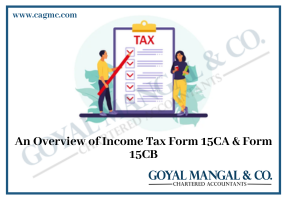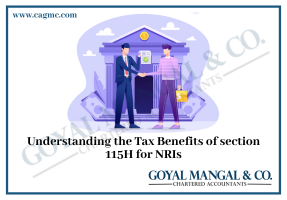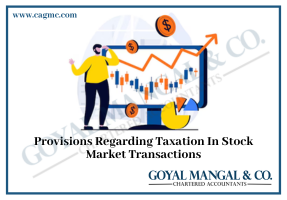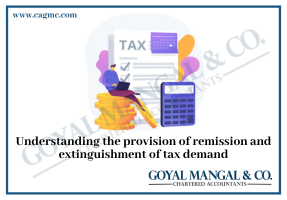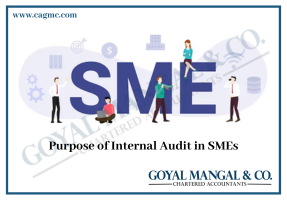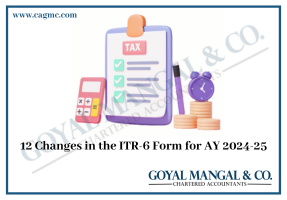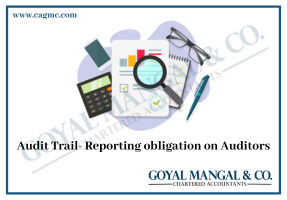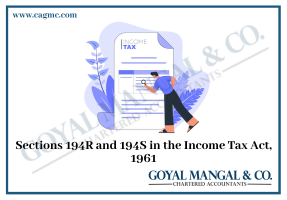
Every assessee who earns more than the basic exemption limit in a Fiscal Year (FY) is to file a statement detailing his income, deductions, and other relevant information. This is known as the Income Tax Return (ITR). The Income Tax Department will process your income tax returns after you file them as a taxpayer. There are times when an assessee’s return is upholding for assessment based on parameters set by the Central Board of Direct Taxes (CBDT). In this article, we’ll discuss the Assessment of Income under Section 143(1).
Meaning of Assessment
Every taxpayer is under obligation to provide the Income Tax Department with information about his or her income. These details must be provided by filing his income tax return. Once the taxpayer has filed his or her income tax return, the Income Tax Department will process it. The Income Tax Department verifies the accuracy of the income tax return. The process by which the Income Tax Department examines the return of income is “Assessment”. Section 144 assessment also includes re-assessment and best judgment assessment.
Types of Assessments
The following types of assessments are as follows:
- Summary assessment without calling the assessee under section 143(1)
- Scrutiny Assessment under section 143(3)
- Best Judgment Assessment under section 144.
- Income Escaping Assessment under section 147.
Summary Assessment under Section 143(1) of Income Tax Act 1961
This is a preliminary assessment, also known as a summary assessment because the assessee is not present (i.e., the taxpayer).
- Scope of Summary Assessment: Assessment under section 143(1) is analogous to a preliminary review of an income tax return. At this point, no detailed examination of the income return takes place. Further, at this point, the total income or loss is under computation after making the following (if any) adjustments:
- Any arithmetic mistake in the return; or
- An incorrect claim, If the incorrect claim is obvious from any information in the return;
- Disallowance of loss claimed if the previous year’s return for which set-off of loss is claimed was not submitted by the due date specified in section 139(1); or
- Disallowance of expenditure indicated in the audit report but not included in calculating total income in the return; or
- Disallowance of deductions claimed under sections 10AA, 80IA to 80-IE if the return is filed after the due date specified in section 139(1); or
- Addition of income from Form 26AS, Form 16A, or Form 16 that do not present in calculating total income in the return. No such adjustment, however, shall take place in relation to a return filed for the fiscal year 2018-19.
However, no such adjustment shall take place unless the assessee is notified of the adjustment in writing or electronically. Furthermore, the assessee’s response, if any, will be taken into account before any adjustments take place, and if no answer is received within 30 days of the notification being issued, such changes will be made. Adjustments shall take place.
- Procedure for Summary Assessment: Following is the procedure for Summary Assessment:
- After correcting any arithmetic error or incorrect claim (if any), the tax, interest, and fee, if any, shall be under computation on the basis of the adjusted income.
- Any sum payable by the taxpayer or any refund due to him must be communicated to him.
- Intimation must be prepared or generated and sent to the taxpayer. Further, it should specify the amount determined to be payable by or the amount of refund due to the taxpayer.
- An intimation shall also be sent to the taxpayer if the loss declared in the taxpayer’s income return is adjusted but no tax or interest is payable by him or a refund is due to him.
- In cases where no sum is payable by or refundable to the assessee, or where no adjustment is made to the returned income, the acknowledgment of the return of income is deemed to be the intimation.
A fee is payable under section 234F if the taxpayer does not submit the income tax return by the due date specified in section 139. (1). The penalty for failure to file an income tax return is Rs. 5,000. It follows up when the taxpayer files the return after the due date specified in section 139 (1). However, if an assessee’s total income does not exceed Rs. 5 lakh, it will be Rs. 1,000.
- Time Limit for Summary Assessment: Section 143(1) assessments can take place within 9 months of the end of the fiscal year in which the taxpayer submits the income tax return.
Scrutiny Assessment under section 143(3) of Income Tax Act 1961
This detailed assessment will act as a scrutiny assessment. A detailed examination of the return of income will take place at this stage to confirm the correctness and genuineness of various claims, deductions, and so on made by the taxpayer in the return of income.
- Scope of Scrutiny Assessment: The goal of the scrutiny assessment is to ensure that the taxpayer has not understated his or her income, has not computed an excessive loss and has not underpaid the tax in any way. To verify the aforesaid, the Assessing Officer performs a thorough review of the taxpayer’s income tax return and will satisfy himself as to various claims, deductions, and other items claimed by the taxpayer in the return of income.
- Procedure for Scrutiny Assessment: If the Assessing Officer believes that it is necessary or expedient to ensure that the taxpayer has not mentions his income, does not calculate an excessive loss, or in any way, tax is not payable by him, he will serve on the taxpayer a notice requiring him to attend his office or to produce any evidence on which the taxpayer may rely in support of the return.The Assessing Officer shall serve such notice in accordance with the provisions of section 143(3) in order to carry out the assessment under section 143(2).Section 143(2) requires notice to serve within six months of the end of the fiscal year in which the taxpayer submits the income tax return. The taxpayer or his representative (as the case may be) will appear before the Assessing Officer and present his arguments, supporting evidence, and so on various matters/issues as the Assessing Officer may require. After verifying the evidence and taking into account any particulars provided by the taxpayer as well as any other evidence requested by the Assessing Officer on specific points. And, after taking into account all relevant materials on record, the Assessing Officer shall, by written order, determine the taxpayer’s total income or loss. Furthermore, on the basis of such assessment, he may determine the sum payable by him or refund any amount due to him.
Best Judgment Assessment under section 144 of Income Tax Act 1961
This is a judgment call based on the Assessing Officer’s best judgment based on all relevant information obtained. When a taxpayer fails to meet the standards in section 144 of the Income Tax Act, 1961, an assessment will take place.
- Scope of Best Judgment Assessment: According to Section 144, the Assessing Officer is under obligation to make an assessment to the best of his ability in the following cases:
- If the taxpayer fails to file the required return by the due date specified in section 139(1). Or a belated return under section 139(4), or a revised return under section 139(5).
- If the taxpayer fails to comply with all of the terms of notice as per section 142.
According to the above criteria, best judgment assessment is when the taxpayer does not file its income tax return. Moreover, there is no cooperation by the taxpayer in terms of furnishing information/explanation related to his tax assessment. Or the taxpayer’s books of accounts are not reliable or are incomplete.
- Procedure for Best Judgment Assessment: The following is the procedure for the Best Judgement Assessment:
- If the conditions require the best judgment, the Assessing Officer will serve a notice on the taxpayer requiring him to show cause why the assessment should not completed to the best of his ability.
- In the case where a notice under section 142(1) has been issued prior to the making of an assessment under section 144, no notice as above is in need.
- If the taxpayer fails to convince the AO and AO believes that the case requires the best judgment. Then he will proceed to carry out the assessment to the best of his ability.
- If the criteria for the best judgment assessment are meeting, the Assessing Officer shall assess the total income or loss to the best of his knowledge/judgment, after taking into account all relevant materials on record by the Assessing Officer and after giving the taxpayer an opportunity to present its contention, and determine the sum payable by the taxpayer on the basis of such assessment.
- Time Limit for Best Judgment Assessment: Section 153 specifies the time limit for making an assessment under Section 144 as follows:
- Within 21 months of the end of the assessment year in which the income was first reported [for assessment years 2017-18 or earlier]
- 18 months from the end of the assessment year in which the income was first reported [for the 2018-19 fiscal year]
- Within 12 months of the end of the assessment year in which income was first reported [Applicable for assessment years 2019-20 and 2020-21]
- Within 9 months of the end of the assessment year in which income was first reported [Applicable for assessment years 2021-22 and later]
Note: If there is a reference is to TPO, the assessment period will get an extension of 12 months.
Income Escaping Assessment under section 147 of Income Tax Act 1961
The previous year’s income of a taxpayer is under assessment during the corresponding assessment year. Some sources of income may evade taxation on occasion. In such a case, if the Assessing Officer (AO) discovers that some income that is actually chargeable to tax is not under proper assessment. In that case, the officer has the authority to reassess the individual’s income tax returns under Section 147.
Now that you understand what this act means, let’s take a look at what an Assessing Officer can do if he becomes aware of income-escaping assessment. Section 148 of the Income Tax Act, 1961 allows the officer to issue a notice.
The notice under section 148 may be issued if the following conditions are met:
- The AO has some information indicating that some taxable income has escaped assessment.
- The AO obtains certification from the certified head before issuing the notice under this section.
- Scope of Income Escaping Assessment: The scope of assessment under Section 147 of the Income Tax Act is uncertain and not clear. The AO conducts assessments under this section with one goal in mind: to bring any taxable income that has not under subject to assessment and duly taxed within the scope of taxation. As a result, Section 147 applies to any taxable income that may have escaped the original assessment. And what exactly is “original assessment”? It is simply the assessment of income under sections such as 143(1), 143(3), 144, and 147 of the Act. This is because when we consider an income is to have escaped taxation.
- If your total income in the previous year exceeded the maximum amount not chargeable to tax. However, you failed to file your income tax return.
- If you have filed your Income Tax Return but no assessment has been made for it. And the AO determines that you have either claimed excess loss, deductions, or allowances or shown less income than you earned.
- Procedure for Income Escaping Assessment: The procedure outlined in Section 147 of the Income Tax Act is fairly simple and straightforward. Here are the procedure’s specifics:
- Before making an assessment under Section 147, the AO sends a notice to the taxpayer under Section 148.
- The taxpayer has the opportunity to present its contention.
- If the AO discovers that some income was not assessed, it is assessed or reassessed as necessary.
- If necessary, the AO can recalculate the loss, depreciation, allowance, and so on.
This section’s assessment cannot take place for any income that is the subject of an appeal or revision.
- Time Limit for Income Escaping Assessment: Section 147 of the Income Tax Act also specifies a time limit for completing the assessment. This time limit is as per Section 153 of the Act, which states that the AO must make the assessment under Section 147 within one year of the end of the fiscal year in which the notice under Section 148 is issue to the taxpayer.For example, if the AO issued you a notice under Section 148 on October 10, 2020, they must complete the assessment under Section 147 of the Income Tax Act within one year of the end of the fiscal year 2020-21. Furthermore, if the income escaping assessment is Rs 1 lakh or less, the Assessing Officer can generally only issue a notice u/s 148 within four years of the end of the relevant assessment year. There are, however, exceptions to this rule. This time limit extends as specified in the following cases.
- If the income-escaping assessment exceeds one lakh, the time limit is six years.
- The time limit is 16 years if the income-escaping assessment is related to assets located outside of India.
Endnote
So, if you receive a notice under the Income Tax Act, you now know it is about assessment. Examine the income that may have escaped assessment as a result of the AO’s notice. And if you have a legitimate reason or explanation for this, ensure that you communicate it to the Assessing Officer in accordance with the proper procedure.
